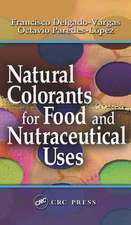Novel Techniques in Sensory Characterization and Consumer Profiling
Editat de Paula Varela, Gastón Aresen Limba Engleză Paperback – 14 oct 2016
Novel Techniques in Sensory Characterization and Consumer Profiling provides a comprehensive overview of classical and novel methods for sensory characterization of food and nonfood products. The book presents the history behind descriptive analysis, describes the most common novel methodologies and detailed information for their implementation, and discusses examples of applications and case studies. It also includes an introduction to exploratory multivariate analysis, addressing the theory and application of some of the most useful multivariate statistical tools applied in the analysis of consumer profiling data sets.
Most of the data analysis is implemented in the statistical free software R, making the book accessible to readers unfamiliar with complex statistical software.
Chapters examine a range of techniques including the ideal profile method, just-about-right scales in consumer research, free choice profiling, flash profiling, and repertory grid methods. They cover emerging profiling methods, such as sorting, and projective mapping or Napping®. Other techniques less frequently used for sensory profiling are also considered: the application of open-ended questions for sensory characterization, polarized sensory positioning, and the consumer-friendly check-all-that-apply questions. In addition, dynamic sensory characterization methods, useful for studying temporal aspects of in-mouth sensory perception, are described. The final chapter provides a critical comparison of the methodologies discussed, their advantages and disadvantages, and general recommendations for their application.
| Toate formatele și edițiile | Preț | Express |
|---|---|---|
| Paperback (1) | 555.05 lei 6-8 săpt. | |
| CRC Press – 14 oct 2016 | 555.05 lei 6-8 săpt. | |
| Hardback (1) | 1408.93 lei 6-8 săpt. | |
| CRC Press – 23 apr 2014 | 1408.93 lei 6-8 săpt. |
Preț: 555.05 lei
Preț vechi: 765.08 lei
-27% Nou
Puncte Express: 833
Preț estimativ în valută:
106.21€ • 110.89$ • 87.90£
106.21€ • 110.89$ • 87.90£
Carte tipărită la comandă
Livrare economică 04-18 aprilie
Preluare comenzi: 021 569.72.76
Specificații
ISBN-13: 9781138034273
ISBN-10: 1138034274
Pagini: 416
Ilustrații: 109
Dimensiuni: 156 x 234 x 27 mm
Greutate: 0.59 kg
Ediția:1
Editura: CRC Press
Colecția CRC Press
Locul publicării:Boca Raton, United States
ISBN-10: 1138034274
Pagini: 416
Ilustrații: 109
Dimensiuni: 156 x 234 x 27 mm
Greutate: 0.59 kg
Ediția:1
Editura: CRC Press
Colecția CRC Press
Locul publicării:Boca Raton, United States
Public țintă
Professional ReferenceCuprins
Introduction. Classical Descriptive Analysis. Introduction to Multivariate Statistical Techniques for Sensory Characterization. Ideal Profiling. Use of Just-About-Right Scales in Consumer Research. Free-Choice Profile Combined with Repertory Grid Method. Flash Profile. Free Sorting Task. Projective Mapping and Napping. Polarized Sensory Positioning Methodologies. Check-All-That-Apply Questions. Open-Ended Questions. Dynamic Sensory Descriptive Methodologies: Time–Intensity and Temporal Dominance of Sensations. Comparison of Novel Methodologies for Sensory Characterization. Index.
Notă biografică
Paula Varela is a food engineer from Universidad de la República, Uruguay. She earned her PhD in food science and technology from Universidad Politécnica de Valencia, Spain. She has wide experience both in academic and industrial research in sensory and consumer science, having worked in collaboration with various research groups from Europe, Asia, and South America. She recently joined Nofima – The food Research Institute (Norway) as senior scientist. Dr. Varela has published more than 60 SCI papers and various book chapters, and has made several contributions to international symposiums. Dr. Varela collaborates as reviewer in various journals in this field and is a member of the editorial board of Food Research International. In recent years, her research has focused on the exploration of new methodologies to further the understanding of consumer perception, in particular sensory descriptive techniques with the use of consumers and the influence of non-sensory parameters in consumer food choice.
Gastón Ares is a food engineer. He received his PhD in chemistry, with a focus on sensory and consumer science, from Universidad de la República, Uruguay. He works as professor and researcher in the Food Science and Technology Department of the Chemistry Faculty at the same university. He has authored more than 80 articles in international refereed journals and numerous presentations in scientific meetings. He was awarded the 2007 Rose Marie Pangborn Sensory Science Scholarship, granted to PhD students in sensory science worldwide. In 2011, he won the Food Quality and Preference Award for a young researcher for his contributions to sensory and consumer science. He is a member of the editorial boards of both the Journal of Sensory Studies and Food Quality and Preference, as well as an associate editor of Food Research International.
Gastón Ares is a food engineer. He received his PhD in chemistry, with a focus on sensory and consumer science, from Universidad de la República, Uruguay. He works as professor and researcher in the Food Science and Technology Department of the Chemistry Faculty at the same university. He has authored more than 80 articles in international refereed journals and numerous presentations in scientific meetings. He was awarded the 2007 Rose Marie Pangborn Sensory Science Scholarship, granted to PhD students in sensory science worldwide. In 2011, he won the Food Quality and Preference Award for a young researcher for his contributions to sensory and consumer science. He is a member of the editorial boards of both the Journal of Sensory Studies and Food Quality and Preference, as well as an associate editor of Food Research International.
Descriere
Sensory characterization is one of the most powerful, sophisticated, and extensively applied tools in sensory science. This book focuses on sensory characterization of food and non-food products, providing an overview of classical and novel alternative methodologies. A complete description of the methodologies is provided, accompanied by detailed information for implementation, discussion of examples of applications, and case studies. The implementation of the majority of the methodologies is performed in the statistical free software R, making the book accessible for people unfamiliar with complex statistical software.


















